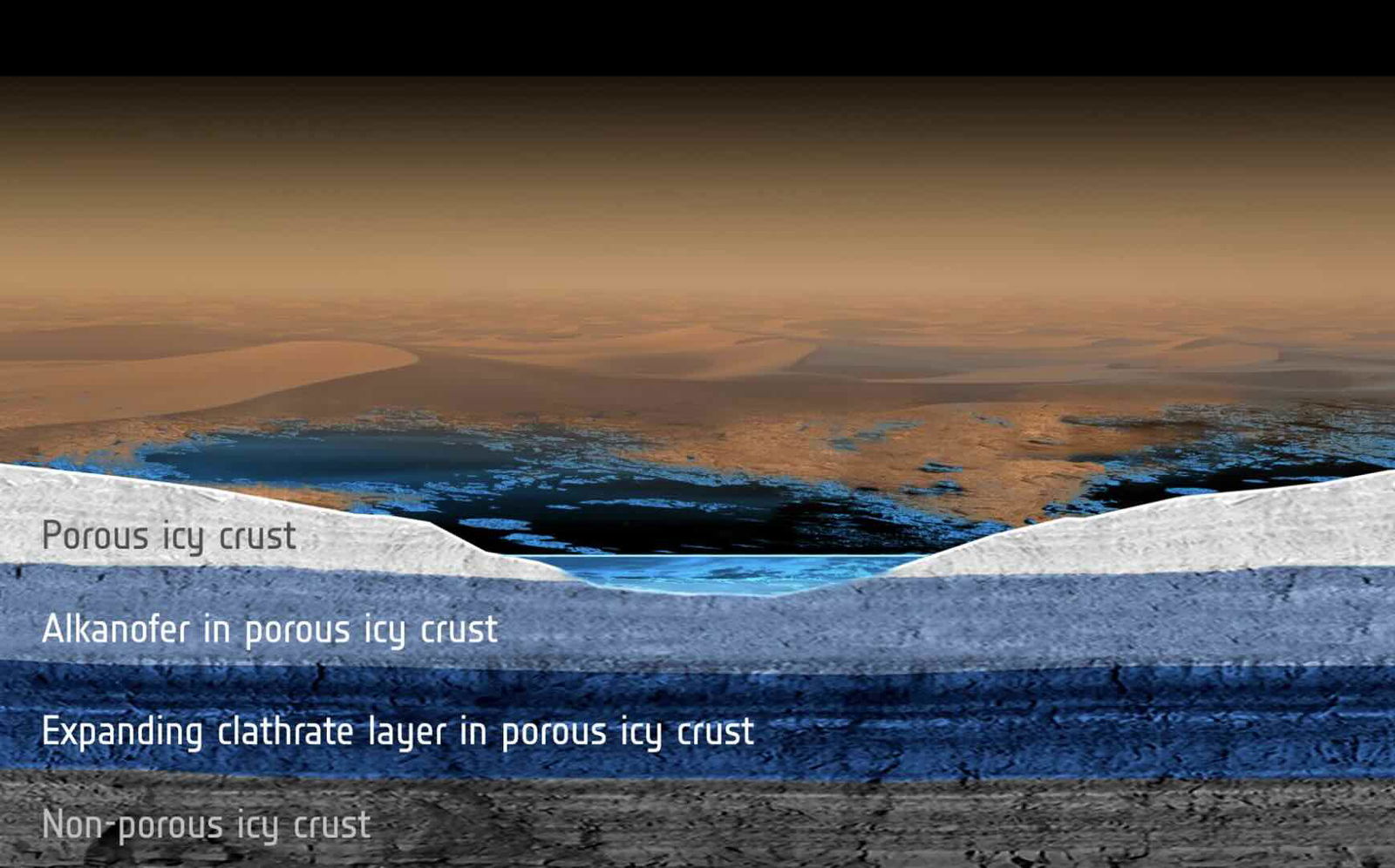Newly published research is upending previous thinking about the geology of Titan, Saturn’s largest moon, suggesting it possesses a crust of methane-rich ice that may help warm its interior and could also promote the existence of life.
The research, conducted by a team of planetary scientists with the University of Hawai’i at Mānoa, reveals evidence for the presence of methane clathrates in Titan’s frozen crust. These solid structures, which may capture pockets of methane gas, could help explain past observations of the Saturnian moon that revealed shallow impact craters on its surface and the moon’s methane rich atmosphere.
Fundamentally, the new findings could point to the existence of a warmer interior—and a more dynamic one—on Titan than past research has suggested, offering new perspectives on the alien moon, as well as potentially revealing insights into methane processes occurring here on Earth.
Titan: A Frozen Moon with a Warm Interior?
Titan has long captured the fascination of astronomers, and not just due to its prevalence as the largest of Saturn’s moons. Right now, it is also the only other place in our solar system that astronomers have identified which hosts an atmosphere and the presence of surface liquids that comprise seas and lakes of frigid methane and ethane.
The moon’s surface is also host to large amounts of water ice, which likely contains pockets of methane gas, based on the newly published findings of scientists at the University of Hawai’i at Mānoa.
Detailed in a new paper, the team says Titan’s methane-rich crust could be nearly six miles thick and could trap heat within the moon’s inner shell. This process may help explain the rich presence of methane within Titan’s atmosphere and suggests that the planet’s interior may be warmer than previously thought.


The team, led by planetary scientist Lauren Schurmeier along with Gwendolyn Brouwer and Sarah Fagents, found that despite Titan’s large size, its impact craters are far more shallow than those observed on Earth’s comparatively smaller moon.
“This was very surprising,” Schurmeier says, since observations of other moons had previously led astronomers to “expect to see many more impact craters on the surface and craters that are much deeper than what we observe on Titan.”
To account for this oddity, Schurmeier and her colleagues speculated that there may be some unique process occurring on Titan that could allow craters to vanish more quickly after they are formed.
Analyzing Titan’s Craters with Computer Modeling
Examining the dynamics of Titan’s craters using computer models, Schurmeier and her team began to test how the surface of Saturn’s largest moon might change following an impact event. Specifically, the team wanted to gauge the possibility that the moon’s icy exterior was insulated by methane clathrate ice, a type of ice that traps methane gas within its crystal structure.
In the team’s paper, the authors explain that they employed “finite element modeling to test whether a clathrate crust 5, 10, 15, or 20 km thick could warm the ice shell and relax craters to their currently observed depths or remove them completely.” Modeling the changes in their crater diameters based on past depth-diameter trends observed in the craters of Ganymede, one of Jupiter’s moons, the team reports that “all clathrate crustal thicknesses result in rapid topographic relaxation, despite Titan’s cold surface temperature.”
Simulating a variety of different initial crater depths, the team determined that the presence of clathrate crust somewhere between five and ten kilometers in thickness could potentially account for the shallow craters on Titan.
“The methane clathrate crust warms Titan’s interior and causes surprisingly rapid topographic relaxation,” Schurmeier explained, likening this process to the same way warm glaciers tend to move more quickly here on Earth.
Determining the thickness of Titan’s methane clathrate crust also could offer clues to the origin of the methane-rich atmosphere revealed through past observations.
“Titan is a natural laboratory to study how the greenhouse gas methane warms and cycles through the atmosphere,” said Schurmeier, who notes that on Earth, the presence of similar methane clathrate hydrates in permafrost beneath Arctic seafloors are known to be releasing methane as they become less stable with time. Ultimately, conditions being observed on Titan could offer insights into such methane processes occurring here, and how they may impact Earth’s climate.
Warming Up to Ideas on Alien Life
One of the most intriguing possibilities regarding the dynamics involving methane occurring on Titan involves how such processes may point to the moon having a warmer interior than previously thought, a possibility that could raise the chances of life forms existing there.
“Methane clathrate is stronger and more insulating than regular water ice,” Schurmeier said in a recent statement, explaining that the presence of a clathrate crust could allow the interior of the planet to be insulated, meaning that Titan’s ice shell may be warm and ductile, thereby capable of facilitating slow convection.
Schurmeier adds that a warm ice shell undergoing convection, where warmer material is carried upward, could also help transport potentially detectable biomarkers toward the surface, raising the chances of their discovery by future spacecraft sent to scour the moon for signs of life.
A good candidate for such explorations may be NASA’s upcoming Dragonfly mission, which is expected to launch in 2028 and reach Titan by around 2034. The mission will offer scientists and unprecedented chance to explore the moon’s icy surface, and as our understanding of Titan and its methane-rich atmosphere continues to expand, clathrate processes like those recently explored by Schurmeier and her team could help to provide a basis for exciting future discoveries.
The team’s recent paper, “Rapid Impact Crater Relaxation Caused by an Insulating Methane Clathrate Crust on Titan,” was published in The Planetary Science Journal.
Micah Hanks is the Editor-in-Chief and Co-Founder of The Debrief. He can be reached by email at micah@thedebrief.org. Follow his work at micahhanks.com and on X: @MicahHanks.

